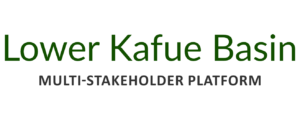About Us
- >
- About Us
Table of Contents
About Us
The Lower Kafue Basin Multistakeholder Platform (MSP) is a collaborative governance approach that brings together diverse actors, including state institutions, private sector, communities, civil society, academia, and traditional authorities, to address complex, interconnected challenges at the landscape or sectoral level.
Mission
The Lower Kafue Basin Multistakeholder Platform (MSP) mission is to enhance collective efforts in sustainable management of the land-water-foodscape nexus, promoting resilient communities through sustainable livelihood practices and holistic integrated management of basin resources, while strengthening adaptive management, improving livelihoods, and fostering collaboration, transparency, and accountability among stakeholders.


Vision
The Lower Kafue Basin Multistakeholder Platform (MSP) vision is to envision a sustainable, resilient, and equitable Lower Kafue Basin, where aquatic food systems, land resources, and communities thrive, driven by collaborative governance, inclusive decision-making, and innovative solutions, ultimately contributing to Zambia’s development goals and sustainable development objectives
History Summary
The Lower Kafue Basin Multistakeholder Platform (MSP) was formed in response to conflicting claims and resource governance issues threatening the sustainability of aquatic food systems in Zambia’s Lower Kafue Basin.
Overharvesting wild aquatic food stocks and poor governance of aquatic commons drove marginalization of traditional fishers and inequities in supply chains. Recognizing the need for collaborative governance, international organizations like the International Water Management Institute (IWMI) and WorldFish, in collaboration with government and non-state partners, launched a multi-sectoral initiative. This led to the establishment of the MSP, anchored on an integrated landscape approach, to address these challenges through inclusive and equitable representation, research-informed decision-making, and holistic management of land, water, and food systems.

Catchment Area

The Lower Kafue Basin Multistakeholder Platform (MSP) catchment area refers to the geographical region encompassing the Lower Kafue Basin in Zambia. Specifically;
Boundaries
The catchment area includes six chiefdoms:
- Chief Nalubamba of Namwala
- Chief Choongo of Monze
- Chief Hamusonde of Monze
- Chief Mungaila of Namwala
- Chieftainess Muwezwa of Itezhi-Tezhi
- Chief Mwanachingwala of Mazabuka
Population
- Approximately 500,000 people reside within the catchment area.
- Local communities rely heavily on the basin’s resources for livelihoods.
Key Features
- Rivers: Kafue River, Lunga River, and Kabompo River
- Wetlands: Kafue Flats
- Land uses: Agriculture, livestock, forestry, and fishing
Economic Significance
- Agriculture: Maize, cotton, tobacco, and livestock production
- Fishing: Commercial and artisanal fishing industries
- Hydropower: Kafue Gorge Hydroelectric Power Station
Why the Lower Kafue Basin was chosen
The Lower Kafue Basin was chosen due to its significant economic, social and environmental importance to Zambia. Approximately 50% of the population depends on it for livelihoods, and it contributes substantially to the economy.
The basin is home to the Kafue Flats wetland, a vital ecosystem hosting two national parks and diverse wildlife, and supplies 44% of Lusaka’s water and 20% of the national cattle herd. Focusing on the Lower Kafue Basin enables targeted interventions to address specific challenges, maximize benefits for local communities and protect the environment, making it an ideal focus area for sustainable development initiatives
Project Scope
The Lower Kafue Basin Multistakeholder Platform (MSP) project scope aims to improve livelihoods and sustainable natural resource management in the Lower Kafue Basin, covering areas in Zambia and potentially neighboring countries.
The project encompasses three working groups: Conservation and Management, Sustainable Livelihoods, Knowledge and Information. Key activities include stakeholder engagement, conservation planning, livelihoods enhancement, climate change adaptation, knowledge management and policy advocacy.
The project seeks to achieve improved livelihoods, enhanced conservation, strengthened community resilience and effective governance, with expected outcomes including increased income generation, access to markets and financial services, and effective governance frameworks

Objectives
- Enhance sustainable management of aquatic food systems, land resources, and water resources.
- Promote resilient communities through sustainable livelihood practices.
- Strengthen adaptive management and governance of aquatic food systems.
- Facilitate knowledge sharing, information exchange, and effective communication among stakeholders
Thematic Focus Areas
Environmental Sustainability
- Aquatic Food Systems: Sustainable fishing practices, aquatic resource management
- Conservation: Protection of wetlands, biodiversity, and ecosystem services
- Water Resources Management: Efficient use, conservation, and governance
- Land Degradation: Soil conservation, sustainable agriculture practices
Livelihoods and Economic Development
- Sustainable Agriculture: Crop and livestock production, value chain development
- Fisheries Management: Responsible fishing practices, market access
- Entrepreneurship: Support for small-scale enterprises, innovation
- Community Development: Capacity building, social cohesion
Governance and Institutional Strengthening
- Collaborative Governance: Multi-stakeholder engagement, decision-making
- Institutional Strengthening: Capacity building, coordination among stakeholders
- Policy Advocacy: Influence policy reforms, supportive legislation
- Transparency and Accountability: Open governance, monitoring and evaluation
Knowledge Management and Research
- Research and Development: Scientific studies, knowledge sharing
- Information Dissemination: Communication, awareness raising
- Capacity Building: Training, workshops, and knowledge transfer
- Monitoring and Evaluation: Impact assessment, performance tracking
Social and Community Development
- Community Engagement: Participation, empowerment
- Social Cohesion: Conflict resolution, community mediation
- Health and Nutrition: Access to clean water, sanitation, hygiene
- Education and Training: Skills development, vocational training
